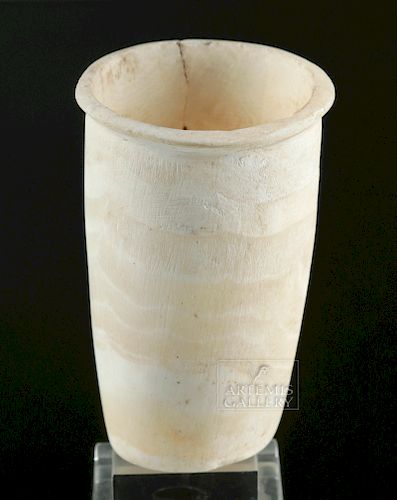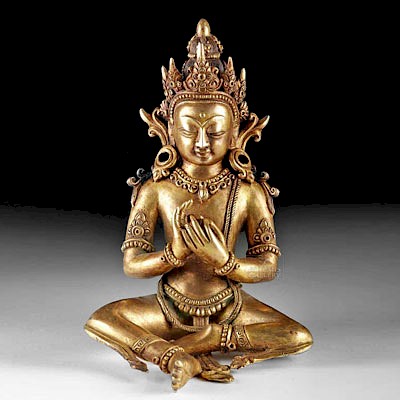Lovely Egyptian Alabaster Cup
Lot 4a
About Seller
Artemis Fine Arts
686 S Taylor Ave, Ste 106
Louisville, CO 80027
United States
Selling antiquities, ancient and ethnographic art online since 1993, Artemis Gallery specializes in Classical Antiquities (Egyptian, Greek, Roman, Near Eastern), Asian, Pre-Columbian, African / Tribal / Oceanographic art. Our extensive inventory includes pottery, stone, metal, wood, glass and textil...Read more
Estimate:
$900 - $1,350
Absentee vs Live bid
Two ways to bid:
- Leave a max absentee bid and the platform will bid on your behalf up to your maximum bid during the live auction.
- Bid live during the auction and your bids will be submitted real-time to the auctioneer.
Bid Increments
| Price | Bid Increment |
|---|---|
| $0 | $25 |
| $300 | $50 |
| $1,000 | $100 |
| $2,000 | $250 |
| $5,000 | $500 |
| $10,000 | $1,000 |
| $20,000 | $2,500 |
| $50,000 | $5,000 |
| $100,000 | $10,000 |
| $200,000 | $20,000 |
About Auction
By Artemis Fine Arts
Jun 6, 2019
Set Reminder
2019-06-06 10:00:00
2019-06-06 10:00:00
America/New_York
Bidsquare
Bidsquare : VARIETY AUCTION | Ancient & Ethnographic
https://www.bidsquare.com/auctions/artemis-gallery/variety-auction-ancient-ethnographic-4182
Around the world & back in time - be amazed at the treasures you will find. Antiquities from Egypt, Greece, Italy and the Near East, Asian, Pre-Columbian, African / Tribal / Oceanic, Native American, Spanish Colonial, Russian Icons, Fine Art, much more! All categories, all price ranges...all legal Artemis Fine Arts info@artemisgallery.com
Around the world & back in time - be amazed at the treasures you will find. Antiquities from Egypt, Greece, Italy and the Near East, Asian, Pre-Columbian, African / Tribal / Oceanic, Native American, Spanish Colonial, Russian Icons, Fine Art, much more! All categories, all price ranges...all legal Artemis Fine Arts info@artemisgallery.com
- Lot Description
Ancient Egypt, Late Period, 26th to 31st Dynasty, ca. 672 to 332 BCE. A beautiful cup, of cylindrical form, with a round, flat foot, and thick rim, carved from a gorgeous piece of alabaster. The skill of the artist is demonstrated by how thin the walls are. This allows the stone to glow with a butter-like color when held to the light. Bands of a whiter color are visible throughout the walls of the cup. Size: 2.45" W x 4" H (6.2 cm x 10.2 cm)
Alabaster was quarried along the length of the Nile, from Giza to just south of Luxor. Offering vessels were used in temples and placed in the tombs of people at all class levels. For example, Auguste Mariette, the famous French Egyptologist of the 19th century, found a cemetery for the poor in Memphis where the dead had been buried without wrappings only three feet below the ground - but each had a small alabaster bowl and some animal bones, as they had been given food and drink for the afterlife. Meanwhile, kings were buried with many vessels, often of the highest quality. These vessels were necessary to provision the dead during their time in the underworld.
Provenance: private East Coast, USA collection; ex-William Froelich collection, New York, USA, collected in the 1970s
All items legal to buy/sell under U.S. Statute covering cultural patrimony Code 2600, CHAPTER 14, and are guaranteed to be as described or your money back.
A Certificate of Authenticity will accompany all winning bids.
We ship worldwide and handle all shipping in-house for your convenience.
#143440Two hairline fissures down from the rim on one side. Small chips and scratches commensurate with age. Light deposits on surface.Condition
- Shipping Info
-
All shipping is handled in-house for your convenience. Your invoice from Artemis Gallery will include shipping calculation instructions. If in doubt, please inquire BEFORE bidding for estimated shipping costs for individual items.
-
- Buyer's Premium



 EUR
EUR CAD
CAD AUD
AUD GBP
GBP MXN
MXN HKD
HKD CNY
CNY MYR
MYR SEK
SEK SGD
SGD CHF
CHF THB
THB
















